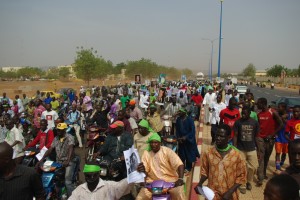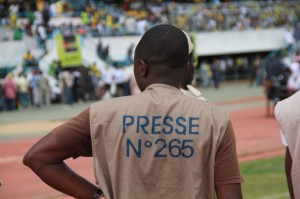Keeping safe in protests
 As journalists we often have to cover protests. When people are passionate enough about an issue to get out onto the streets, it usually means there is a story worth telling. And when protests get out of hand that can be newsworthy too. But how to stay safe when covering protests? Below are a few points I keep in mind when I’ve got a protest to cover. I’m sure I’ve missed some good tips though so comment below with any advice you’d like to add.
As journalists we often have to cover protests. When people are passionate enough about an issue to get out onto the streets, it usually means there is a story worth telling. And when protests get out of hand that can be newsworthy too. But how to stay safe when covering protests? Below are a few points I keep in mind when I’ve got a protest to cover. I’m sure I’ve missed some good tips though so comment below with any advice you’d like to add.
Preparation:
- Make contact with the protest organisers, the police, fellow journalists and any other groups who might be able to help. Keep a list of numbers to take with you to the event.
- Find out as much as you can about the protest e.g. Who is protesting? Where are they planning to march? Any violent groups within the protestors? How many police are going to be deployed?
- Think about the best vantage point to cover the protest. Do you really need to be among the protestors? Is it possible to talk to a few protestors and then watch events from a tall building nearby for example?
- Think about whether you want to be easily identifiable as a journalist. Usually you’ll want people to know you are a journalist. But there are occasions where you would rather just melt into the crowd.
- If you want people to know you are a journalist, the best way is with clothing that prominently says “PRESS” on the front and back. If you don’t have something like this, then use your equipment to help you stand out. Keep your microphone or camera in your hand – people will get the idea.
- I like to take as little equipment with me to a protest as possible. If you have to move fast, it’s not fun to have a heavy camera. Wear shoes you can run in.
- Find someone to go with you. Usually this won’t be a problem as you’ll have colleagues who plan to go too. Agree on somewhere to meet up away from the action.
- Tell someone where you are going and when you expect to be back. It is also good to let a senior person at your media organisation know you are headed to a protest.
While there:
- Keep aware. This is really the most important point. Especially when doing interviews or filming, you can get very involved in what you are doing. If things are looking tense, take it in turns with a colleague so while one of you is working there is always someone keeping an eye on what is going on.
- If things are looking tense, you should be constantly thinking about what you will do if things get worse. Look for escape routes, places you could go to be safe.
If things go bad:
- If you are being targeted by the crowd then you need to get out of the area or get away from the people threatening you. Maybe the security forces or organisers can help. This is where the contacts you made earlier can be really helpful.
- If it’s general chaos, clashes, get somewhere safe fast. Keep in mind that people often throw things (like big rocks) during protests so being behind a wall might not be enough; inside is better.
- If tear gas is fired you need to get away from the area affected. The usual advice is to try to wash your eyes with clean water. Remove and wash your clothes and wash your body.
- If there is gunfire, you need to find proper cover. Remember AK-47 rounds can get through a single brick wall.
Final point, even the best story isn’t worth your life. Better to be safe and have seen a little less, than ending up injured.
Martin has been a reporter for more than ten years, working mainly in radio and print. He lived in Bamako, Mali for the last three and a half years and worked as a correspondent for various international media. Martin regularly trains journalists in North and West Africa for DW Akademie.
3 Comments






Sarah Mersch | Monday 2012-10-15
In my experience, coke or a mixture of baking soda and water are much more efficient than water to wash your eyes when in contact with tear gas, as are cotton balls dipped into lemon juice to put into the nostrils. Avoid wearing contact lenses or make up, as the irritating agents tend to stick to any greasy substance. Don’t touch tear gas rounds to throw them away from you as they can get very hot and cause severe injury.
harjesc | Monday 2012-10-15
Thanks a lot, Sarah! This sounds like some very helpful advice.
Steve | Thursday 2012-10-18
very useful post!